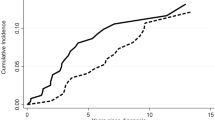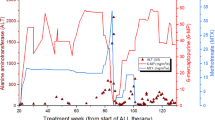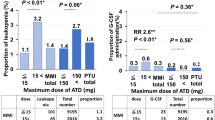Abstract
Twelve boys and 10 girls on similar long term remission maintenance treatment for lymphoblastic leukaemia had 79 random assays of their red cell 6 thioguanine nucleotide ( 6TGN ) concentrations performed as an index of cytotoxic activity generated by oral 6-mercaptopurine ( 6MP ). Correlation between the dose of 6MP and 6TGN was statistically significant in the girls (r = 0.58, P less than 0.001) but not in the boys (r = 0.15). Additionally, as a group the boys tolerated more 6MP (P less than 0.05), despite similar prescribing criteria, but this did not result in a higher mean 6TGN concentration or increased myelotoxicity. It appears that girls develop 6MP cytotoxicity at lower doses and more predictably than boys. If so, this may be relevant to the as yet unexplained but marked sex difference in prognosis apparent in some studies.
This is a preview of subscription content, access via your institution
Access options
Subscribe to this journal
Receive 24 print issues and online access
$259.00 per year
only $10.79 per issue
Buy this article
- Purchase on Springer Link
- Instant access to full article PDF
Prices may be subject to local taxes which are calculated during checkout
Similar content being viewed by others
Rights and permissions
About this article
Cite this article
Lilleyman, J., Lennard, L., Rees, C. et al. Childhood lymphoblastic leukaemia: Sex difference in 6-mercaptopurine utilization. Br J Cancer 49, 703–707 (1984). https://doi.org/10.1038/bjc.1984.111
Issue Date:
DOI: https://doi.org/10.1038/bjc.1984.111
This article is cited by
-
Global comparative transcriptomes uncover novel and population-specific gene expression in esophageal squamous cell carcinoma
Infectious Agents and Cancer (2023)
-
Meta-analysis of randomised trials comparing thiopurines in childhood acute lymphoblastic leukaemia
Leukemia (2011)
-
Identification of factors regulating thiopurine methyltransferase activity in a Norwegian population
European Journal of Clinical Pharmacology (1993)
-
6-Thioguanine: High-dose 2-H infusions in goats
Journal of Cancer Research and Clinical Oncology (1985)



